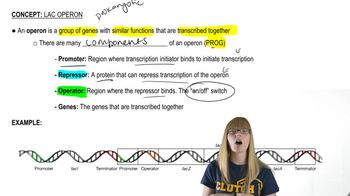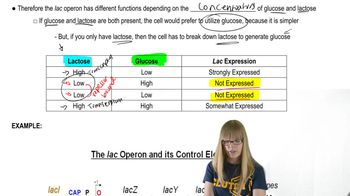Table of contents
- 1. Introduction to Genetics51m
- 2. Mendel's Laws of Inheritance3h 37m
- 3. Extensions to Mendelian Inheritance2h 41m
- 4. Genetic Mapping and Linkage2h 28m
- 5. Genetics of Bacteria and Viruses1h 21m
- 6. Chromosomal Variation1h 48m
- 7. DNA and Chromosome Structure56m
- 8. DNA Replication1h 10m
- 9. Mitosis and Meiosis1h 34m
- 10. Transcription1h 0m
- 11. Translation58m
- 12. Gene Regulation in Prokaryotes1h 19m
- 13. Gene Regulation in Eukaryotes44m
- 14. Genetic Control of Development44m
- 15. Genomes and Genomics1h 50m
- 16. Transposable Elements47m
- 17. Mutation, Repair, and Recombination1h 6m
- 18. Molecular Genetic Tools19m
- 19. Cancer Genetics29m
- 20. Quantitative Genetics1h 26m
- 21. Population Genetics50m
- 22. Evolutionary Genetics29m
12. Gene Regulation in Prokaryotes
Lac Operon
Problem 30a
Textbook Question
For an E. coli strain with the lac operon genotype I⁺ P⁺ O⁺ Z⁺ Y⁺, identify the level of transcription of the operon genes in each growth medium listed. Specify transcription as 'none,' 'basal,' or 'activated' for each medium, and provide an explanation to justify your answer.
Growth medium contains lactose but no glucose.
 Verified step by step guidance
Verified step by step guidance1
<span>Step 1: Understand the lac operon components and their roles. The lac operon in E. coli consists of the following components: I (lacI) is the repressor gene, P is the promoter, O is the operator, Z is the gene for β-galactosidase, and Y is the gene for permease. The lac operon is responsible for the metabolism of lactose.</span>
<span>Step 2: Analyze the genotype I⁺ P⁺ O⁺ Z⁺ Y⁺. This genotype indicates that all components of the lac operon are wild-type and functional. The repressor protein (I⁺) can bind to the operator (O⁺) to inhibit transcription in the absence of an inducer.</span>
<span>Step 3: Consider the presence of lactose in the growth medium. Lactose acts as an inducer by binding to the repressor protein, causing a conformational change that prevents the repressor from binding to the operator. This allows RNA polymerase to access the promoter and initiate transcription.</span>
<span>Step 4: Evaluate the absence of glucose in the growth medium. In the absence of glucose, cyclic AMP (cAMP) levels increase, leading to the formation of the cAMP-CAP complex. This complex binds to the promoter region, enhancing the binding of RNA polymerase and increasing transcription levels.</span>
<span>Step 5: Determine the level of transcription. With lactose present and glucose absent, the lac operon is activated. The repressor is inactivated by lactose, and the cAMP-CAP complex enhances transcription, leading to an 'activated' level of transcription of the operon genes.</span>
Recommended similar problem, with video answer:
 Verified Solution
Verified SolutionThis video solution was recommended by our tutors as helpful for the problem above
Video duration:
2mPlay a video:
Was this helpful?
Key Concepts
Here are the essential concepts you must grasp in order to answer the question correctly.
Lac Operon Structure
The lac operon in E. coli consists of several key components: the promoter (P), operator (O), and structural genes (Z and Y) that code for enzymes involved in lactose metabolism. The I gene produces a repressor that can bind to the operator, blocking transcription. Understanding this structure is essential for analyzing how the presence or absence of lactose and glucose affects gene expression.
Recommended video:
Guided course

Lac Operon Overview
Inducible Gene Expression
The lac operon is an example of an inducible system, meaning that its transcription can be activated in response to specific signals. When lactose is present, it binds to the repressor, causing it to release from the operator, which allows RNA polymerase to transcribe the operon genes. This concept is crucial for determining the transcription level in different growth media.
Recommended video:
Guided course

Penetrance and Expressivity
Catabolite Repression
Catabolite repression is a regulatory mechanism in bacteria that prioritizes the use of glucose over other sugars, such as lactose. When glucose is present, the levels of cyclic AMP (cAMP) are low, leading to reduced activation of the lac operon. In the absence of glucose, cAMP levels rise, enhancing the binding of the cAMP-CAP complex to the promoter, which promotes transcription. This concept is vital for understanding the transcription levels in the specified growth medium.
Recommended video:
Guided course

Lac Operon Regulation

 4:27m
4:27mWatch next
Master Lac Operon Overview with a bite sized video explanation from Kylia Goodner
Start learning

